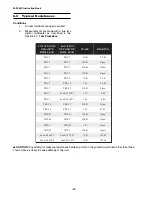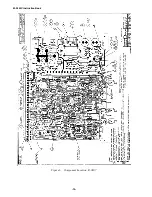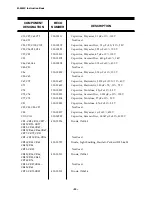
–8–
M-0245C Instruction Book
Phase Angle OK to Output Contact Response
Time
1.
Set the PHASE ANGLE LIMIT dial to 20°.
2.
Apply 120 V rms, 60 [50] Hz to the Line
voltage input.
3.
Apply 120 V rms, 60 [50] Hz to the Motor
Bus voltage input at a 40° phase angle
with respect to the Line voltage input.
4.
Attach the Channel 1 scope probe to CR64
cathode, with reference to TB1-7.
5.
Change the scope trigger to trigger on a
decrease in phase angle.
6.
Channel 2 should remain attached to
TB2-A and TB2-B.
7.
Jump the phase angle to 0°.
8.
Measure the time delay between the
change in phase angle and the Channel 2
signal going high.
9.
The time delay should be 7 ms (minimum)
to 24 ms (maximum).
10.
Change the scope trigger to trigger on an
increase in phase angle.
11.
Jump the phase angle from 0° to 40°.
12.
Measure the time delay between the phase
angle increasing and the output contact
opening.
13.
The time delay should be 7 ms (minimum)
to 24 ms (maximum).
4.3
Phase Angle Detection Circuit
Rate of Change of Phase Angle
1.
Apply 120 V ac, 60 [50] Hz to the Line
voltage input.
2.
Attach the scope ground to the negative
end of C78; attach the probe to the anode
of CR8.
3.
Begin to slowly adjust the Motor Bus
frequency to approximately 120 V ac,
51 Hz.
4.
The pulse rate should be approximately
one pulse per cycle as the Motor Bus
frequency approaches 51 [41] Hz
K
1 Hz.
5.
Slowly increase the Motor Bus frequency.
Pulses should stop as the frequency rises
above approximately 51 [41] Hz.
4.4
Loss of Voltage Input
Detection Circuits
Line Voltage Loss
Refer to Figure 4, Line Voltage Loss, for the following
section:
1.
Apply 120 V ac, 60 [50] Hz to the Bus
voltage input.
2.
Apply 120 V ac, 60 [50] Hz to the Line
voltage input.
3.
Place the Channel 1 probe on the anode
of CR19.
4.
Place the Channel 2 probe on the end of
R136 nearest the rear terminal block.
5.
Trigger the scope on Channel 1. Set the
horizontal sweep time at 5 ms/div.
6.
Completely remove the Line voltage inputs.
7.
As shown in Figure 4, the Channel 1 signal
should immediately go high from –15 V to
+15 V, and Channel 2 should go low after
20 ms.
Motor Bus Voltage Loss
Refer to Figure 5 for the following section.
1.
Apply 120 V ac, 60 [50] Hz to the Motor
Bus voltage input.
2.
Apply 120 V ac, 60 [50] Hz to the Line
voltage input.
3.
Place the Channel 1 probe on Test Point
10 (TP10); attach Channel 2 probe to TP9.
4.
Trigger the scope on Channel 1. Set the
horizontal sweep time at 10 ms/div.
5.
Completely remove the Motor Bus voltage
input.
6.
As shown in Figure 5, the Channel 1 signal
should immediately go high from –15 V to
+15 V, and Channel 2 should go high after
approximately 50 ms.
Motor Bus Undervoltage Detector <25%
1.
Reapply 120 V ac, 60 [50] Hz to the Motor
Bus voltage input.
2.
Remove the Channel 1 probe.
3.
Slowly reduce the Motor Bus voltage.
4.
The signal on Channel 2 should go high
as the voltage level drops below 25%.
Summary of Contents for M-0245C
Page 1: ...Instruction Book M 0245C High Speed Sync Check Relay ...
Page 23: ... 14 M 0245C Instruction Book Figure 6 Component Location B 0207 ...
Page 24: ... 15 Figure 7 Variable Speed Motor Application Component Location B 0264 ...
Page 25: ... 16 M 0245C Instruction Book ...
Page 26: ... 17 Figure 8 Schematic X 0245C ...
















































